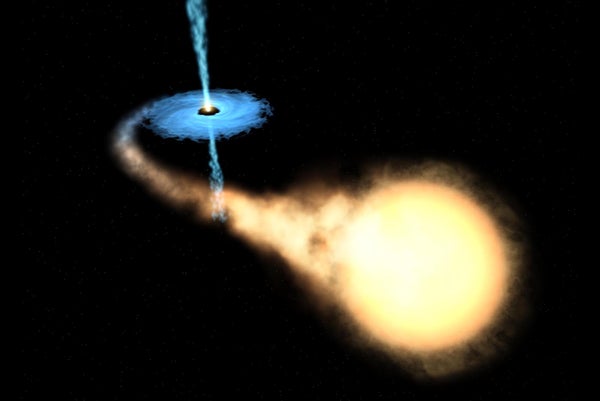Identifying black holes isn’t a matter of simply finding an empty spot in space. These massive objects can famously swallow everything—even light—that could proffer obvious signs of their presence.
Scientists seeking them out must rely on more circumstantial evidence, which comes from the fact black holes are messy eaters: As material funnels into one, it piles up into a spinning disk of glowing debris that can spit out x-rays and enormous jets of subatomic particles. Astronomers have long considered these energetic jets to be a feeding black hole’s calling card—but new observations of similar phenomena from an exotic type of star suggest identifying black holes is about to get even harder.
This black hole imposter is an object called PSR J1023+0038. When a massive, spinning star dies, its leftover core—a city-size ball of stellar ashes known as a neutron star—can continue rotating. Named for its lighthouse-like emissions of photon and electron beams that make it seem to “pulse” with clockwork regularity, such an object is called a pulsar. But PSR J1023 is no run-of-the-mill pulsar—it is a transitional millisecond pulsar, a subtype that spins as much as thousand times per second. That rapid rotation rate comes from the pulsar’s vampirelike feeding on another star, spinning itself up by siphoning off gas from its nearby stellar companion. This scenario, astronomers recently discovered, also causes PSR J1023 to occasionally erupt in jets that mimic those from some black holes.
On supporting science journalism
If you're enjoying this article, consider supporting our award-winning journalism by subscribing. By purchasing a subscription you are helping to ensure the future of impactful stories about the discoveries and ideas shaping our world today.
Theorists think the jets occur when “winds”—massive outflows of particles driven by the pulsar’s twirling magnetic field—temporarily overwhelm PSR J1023’s intense gravitational grip on the in-spiraling gas from its companion, blasting the falling material back out into space.
“It’s like a magnetic slingshot,” says Alessandro Papitto, an astronomer at the Astronomical Observatory of Rome, who is unaffiliated with the latest observations of PSR J1023’s jets. Slavko Bogdanov, an astronomer at Columbia University who led the new observations, describes the situation as “a sweet spot where the two [processes] have comparable power.” Bogdanov and a colleague studied PSR J1023 simultaneously in x-ray with NASA's space-based Chandra X-Ray Observatory and in radio wavelengths using the Very Large Array, a network of radio telescopes in the New Mexico desert. They found a connection between the star’s emissions of x-rays and radio waves that reveals the nature of this energetic tug-of-war between gravity and magnetic fields. When the pulsar produced significant x-rays, its radio emissions dimmed—a sign it was accreting material from the companion star when gravity had the upper hand. Conversely, the pulsar’s radio-bright periods correlated with weaker x-ray emissions, when its “magnetic slingshot” effect halted the flow of material onto the star. The research has been submitted to The Astrophysical Journal.
Elucidating how PSR J1023 manufactures its jets could prove vital for distinguishing it from the black holes it mimics—roughly stellar-mass objects that also emit x-ray and radio flares due to material stolen from a nearby companion star. Because both transitional millisecond pulsars and these black holes emerge from a common origin—a massive star with a close-lying companion—they can each be used as complementary ways to study how such systems form, evolve and die. But only, of course, if astronomers can readily distinguish between them. “For [these] black holes, you have this relatively well-behaved trend" defined by the ratio of x-ray to radio emission, says Elena Gallo, an astrophysicist at Massachusetts Institute of Technology who helped identify the relationship in the early 2000s and is unaffiliated with the latest study. Ever since, scientists have increasingly relied on this relationship to easily classify whether certain objects are black holes or neutron stars without resorting to costly campaigns on large telescopes and their scarce availability of observing time.
“There have recently been many candidates for black hole binaries that have been identified based on their x-ray and radio properties,” Bogdanov says. "[PSR J1023] has shown that some [objects] may have masqueraded as binaries, but may actually be millisecond pulsars.”
Thankfully, many of the tens of objects astronomers have already identified as black holes using this technique do not need to be reclassified. According to Gallo, the x-ray–radio ratio should remain reliable for objects heavier than about three times the mass of the sun, which are thought to be too massive to not be black holes, she says. The line between black hole and millisecond pulsar only becomes hazy for smaller, lighter objects below that approximate threshold. Making it clear again will require new observational strategies that look beyond the simple x-ray–radio ratio.
“Stay tuned, because a lot of new astrophysics and understanding of the physics of neutron stars can come from these kind of systems,” Papitto says.
